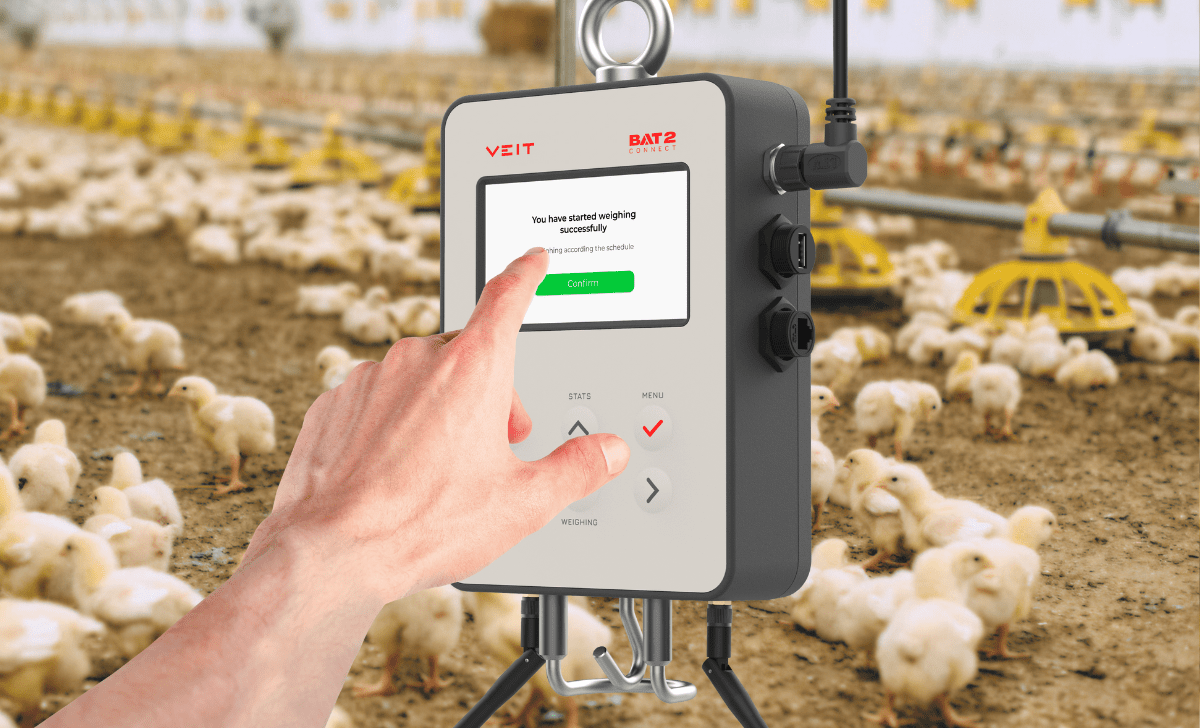Modern poultry farming demands precise monitoring to optimize broiler chicken growth rates and maximize profits. Research reveals a direct correlation between weighing frequency and growth prediction accuracy.
The Weekly Weighing Gap Problem
Traditional manual weighing occurs just once weekly, creating significant data gaps during critical growth periods. Week-on-week broiler weights can vary dramatically, with birds gaining up to almost 1 kg pounds in their final week alone (Purina Animal Nutrition, 2023).
For all its benefits, manual weighing can only provide snapshot data points. This leaves farmers blind to daily fluctuations in broiler chicken weight that could signal health issues requiring immediate intervention.
Continuous Monitoring Breakthrough
Advanced automatic scales like the BAT2 Connect solve this issue through continuous data collection. Research demonstrates that frequent weighing reduces prediction errors to just 0.14% when using four days of historical data for one-day forecasts (Fontana et al., 2016).
The correlation coefficient between expected and observed weights reaches 96% with continuous monitoring systems (Fontana et al., 2016), compared to much lower accuracy with weekly manual measurements. This dramatic improvement enables precise broiler chicken growth chart tracking and early problem detection.
Optimizing Feed Management
Understanding what the ideal broiler feeds are for different stages of growth is powerful information, especially when combined with accurate weight data. Broilers require different nutrition at each phase (Anderson International Corp, 2023):
– Starter phase (0-3 weeks): 23% protein content
– Grower phase (3-6 weeks): 20% protein content
– Finisher phase (6-8 weeks): 17-19% protein content
Real-time weight monitoring through BAT Cloud integration allows farmers to adjust feeding strategies immediately when birds deviate from target broiler chicken growth curves.
Growth Enhancement Strategies
Farmers looking for how to increase the weight of their broiler chickens benefit significantly from frequent monitoring data. Any natural growth promoter for broiler effectiveness can be administered precisely when weight changes are tracked continuously.
Automatic systems can weigh 500 to 3000 birds daily (Mels et al., 2023), providing statistically significant data for management decisions. This frequency enables detection of subtle changes that weekly weighing would miss.
Economic Impact
Research confirms that automatic weighing systems achieve accuracies within ±2% for average weight calculations (Mortensen et al., 2016), enabling confident management decisions based on reliable data.
Continuous weighing technology pays dividends through improved feed conversion ratios and reduced mortality. Birds maintained on optimal growth curves through precise monitoring achieve better market weights with less feed waste.
Sources:
Purina Animal Nutrition. (2023). Meat bird feeding guidelines.
Fontana, I., et al. (2016). Computers and Electronics in Agriculture, 124, 26-33.
Anderson International Corp. (2023). Poultry nutrition comparison study.
Mels, C., et al. (2023). Preventive Veterinary Medicine, 217, 105929.
Mortensen, A.K., et al. (2016). Computers and Electronics in Agriculture, 123, 319-326.
